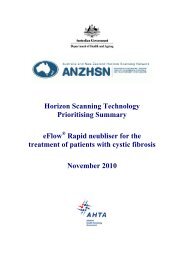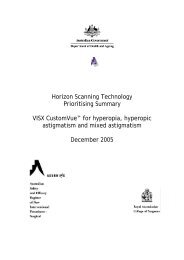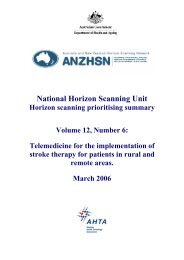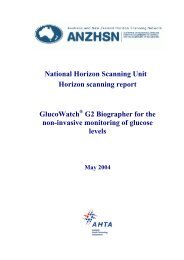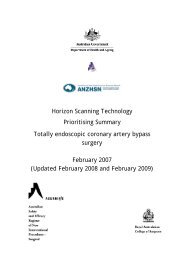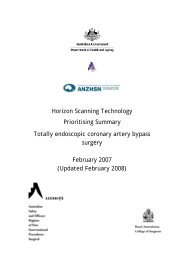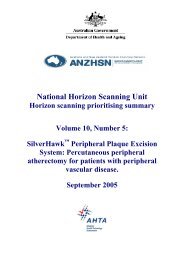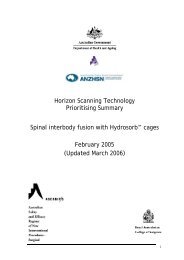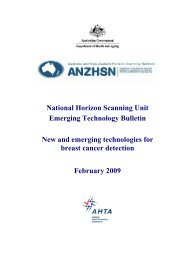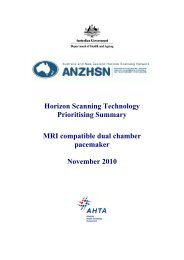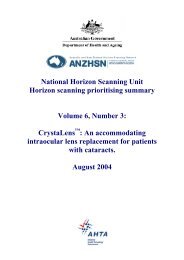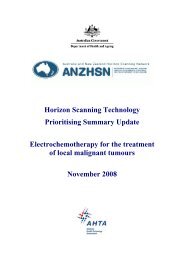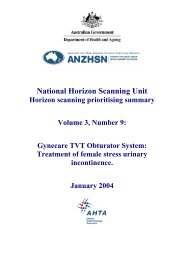Narrow Band Imaging for the improved detection of precancerous ...
Narrow Band Imaging for the improved detection of precancerous ...
Narrow Band Imaging for the improved detection of precancerous ...
You also want an ePaper? Increase the reach of your titles
YUMPU automatically turns print PDFs into web optimized ePapers that Google loves.
wavelengths <strong>of</strong> light penetrate fur<strong>the</strong>r into tissue and different wavelengths areabsorbed differently by structures within <strong>the</strong> tissue. Specifically, blue light (415nm)allows <strong>the</strong> visualisation <strong>of</strong> <strong>the</strong> superficial capillary network as it does not penetrate <strong>the</strong>tissue to a great extent. Green light (540nm) penetrates fur<strong>the</strong>r into <strong>the</strong> tissue allowing<strong>the</strong> visualisation <strong>of</strong> deeper structures such as sub-epi<strong>the</strong>lial vessels. When imagesfrom <strong>the</strong> two light sources are combined a high contrast image <strong>of</strong> <strong>the</strong> tissue surface isgenerated.Figure 1 NBI image acquisition.Blue light only penetrates <strong>the</strong> near surface, whereas green light penetrates to deeper structures (left).The combined image shows <strong>the</strong> capillaries in brown and <strong>the</strong> underlying veins in blue (right).Lesions visualised with NBI can be categorised using two different techniques. Onemethod involves <strong>the</strong> analysis <strong>of</strong> microvasculature, with neoplastic lesions displayingincreased or abnormal microvessel density. A second method developed by Kudo et al(1994) involves analysis <strong>of</strong> <strong>the</strong> “pit pattern” <strong>of</strong> a lesion which results from <strong>the</strong> surfacestructures and superficial mucosal capillaries. The Kudo pit pattern allows <strong>the</strong> lesionto be graded on a scale from nonadenomatous to adenomatous 4 . These methods areapplicable to a variety <strong>of</strong> tissue types, including <strong>the</strong> colon.2008 CLINICAL NEED AND BURDEN OF DISEASEIn 2004 <strong>the</strong>re were 12,977 new cases <strong>of</strong> colorectal cancer diagnosed within Australia.According to <strong>the</strong> AIHW <strong>the</strong>re are no national prevalence data available <strong>for</strong> colorectalcancer (AIHW 2007). In 2006-07 <strong>the</strong>re were a total <strong>of</strong> 230,911 separations <strong>for</strong>colonoscopy as recorded under 4 categories (G43Z Complex Colonoscopy, G44AO<strong>the</strong>r Colonoscopy W Catastrophic or Severe CC, G44B O<strong>the</strong>r Colonoscopy W/OCatastrophic or Severe CC, G44C O<strong>the</strong>r Colonoscopy Sameday) (AIHW 2008). It isnot clear how many <strong>of</strong> <strong>the</strong>se separations are related to colorectal cancer diagnosis.4 Adenomatous lesions are not necessarily cancerous but have <strong>the</strong> risk <strong>of</strong> progression to malignancy.<strong>Narrow</strong> band imaging <strong>for</strong> <strong>the</strong> <strong>detection</strong> <strong>of</strong> <strong>precancerous</strong> lesions: November 2009 Update 6



